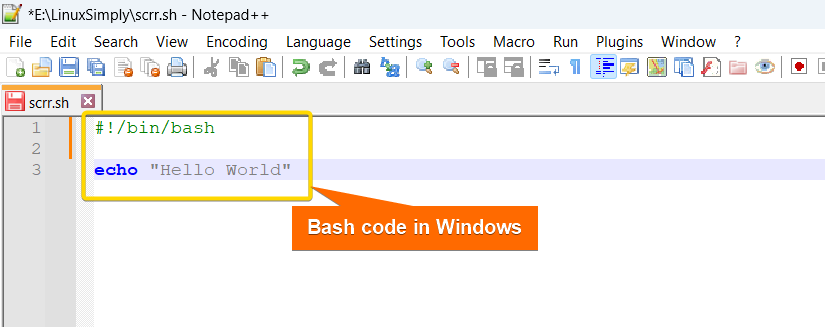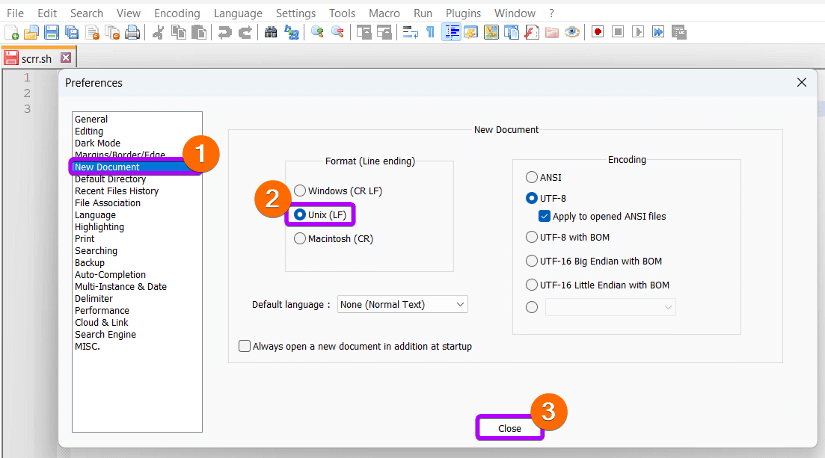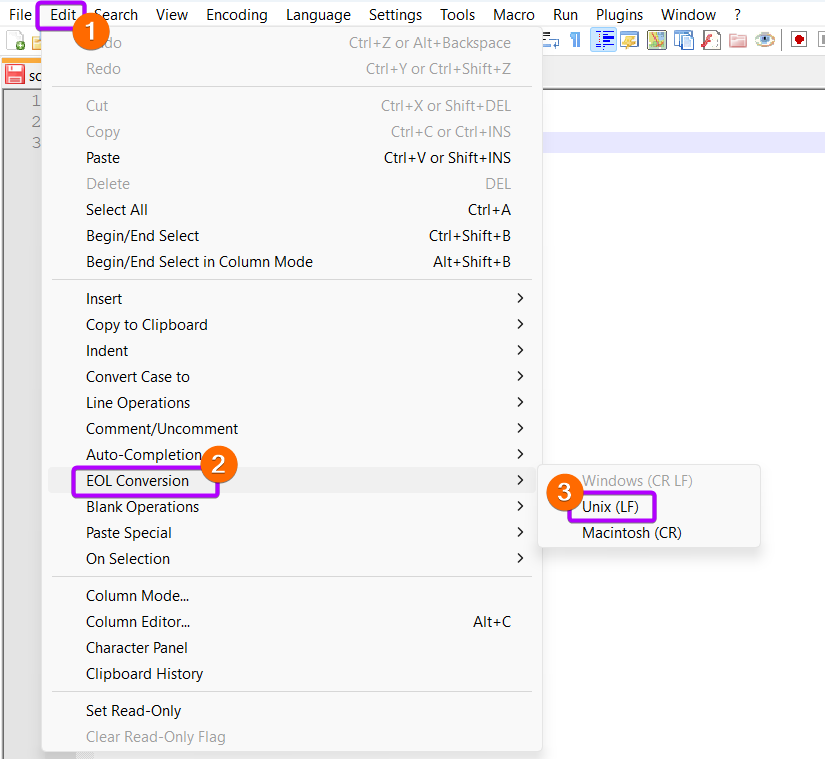The error “/bin/bash^M: bad interpreter: No such file or directory” indicates a problem with line endings in the script. The “^M” character suggests Windows-style line endings (\r\n) are present instead of Unix-style line endings (\n). To resolve this, convert the file to Unix format using the dos2unix or tr command. This article will discuss the method with detailed illustrations along with other alternative methods.
Why the “/bin/bash^M: bad interpreter: No such file or directory” Error Occurs in Bash?
The “/bin/bash^M:bad interpreter: No such file or directory” error in Bash typically occurs due to incorrect line endings in the script file, especially when the script was created or edited on a Windows system and then transferred to a Unix-based system. So whenever you try to execute the bash file which was previously created in a Windows system, you will encounter this error. Here, the “^M” character sequence represents a carriage return (CR) character, which is not recognized as part of the interpreter path.

To check the file type, use the following command:
file script.sh
4 Different Ways to Fix “/bin/bash^M: bad interpreter: No such file or directory” Error in Bash
Here are 4 different ways you can use to fix the “/bin/bash^M: bad interpreter: No such file or directory” error in Bash:
1. Using “dos2unix” Program
You can use the dos2unix program to convert text files from DOS/Windows line endings (CRLF) to Unix/Linux line endings (LF).
To install the dos2unix program in Ubuntu, use the following command:
sudo apt-get install dos2unix
dos2unix script.shFinally, run the script and see successful execution of the file, which implies that the script is no longer in CRLF mode:
2. Using the “tr” Command
If you don’t want to install an external command to change the mode of the text file, Linux already has a built-in tool to remove these newlines. Using the tr command, you can remove the \r part from the line endings and have only the \n terminators.
To change the script file from CRLF to LF mode and remove the possibility of “/bin/bash^M: bad interpreter: No such file or directory”, use the following command:
tr -d '\r' < script.sh > script_unix.shscript.sh is in CRLF mode and script_unix.sh is the converted file in LF mode.
script_unix.sh file using the command below:
chmod u+x script_unix.shThen run the script in your terminal:

3. Using “sed” Command
To replace Windows line endings (CRLF) with Unix line endings (LF) directly, use the sed command in your script file:
sed -i 's/\r//' script.shscript.sh is the script name that you want to change from CRLF to LF.
4. Converting Line Ending in Notepad++
If you are using Notepad++ to edit code, convert line endings to solve the “/bin/bsh^M: bad interpreter” error. This is useful when you use Notepad++ for Windows and for converting the line endings before moving to your Linux environment.
To convert the line ending in your script, first, open the file in Notepad++.

Make sure to save the script before using it in your Linux environment.
Now, if you want to avoid this repetitive task of converting the line ending, you can opt for the default mode.
To use Unix line endings in Notepad++ files by default, open Settings >> Preferences >> New Document


Conclusion
To sum up, using the correct line ending is essential for displaying or executing a file, especially for shell scripts. If your script contains CRLF line terminators, you will encounter a “/bin/bash^M: bad interpreter: No such file or directory” error during the execution. I hope the solutions discussed in this article will prove to be a valuable resource to rectify the problem. Please feel free to comment below if you have any questions or queries related to this. Thank you.
People Also Ask
How to fix bin bash m bad interpreter error?
To fix the “bad interpreter” error, ensure that the shebang line at the beginning of the script correctly points to a valid interpreter path, such as #!/bin/bash for a Bash script. Verify that the path to the interpreter is accurate and the interpreter is installed on your system. If there is any issue in the shebang line then correct the discrepancies, save the file, and attempt to run the script again.
What is a bad interpreter error in the shell?
The “bad interpreter” error in shell scripting typically occurs when the shebang line at the beginning of a script specifies an invalid or non-existent interpreter path. The line begins with “#!”, which indicates the path to the interpreter that should execute the script. If this path is incorrect or the specified interpreter is not installed on the system, then the error occurs. It’s crucial to ensure that the shebang line points to the correct interpreter path,like #!/bin/bash for a Bash script, and that the specified interpreter is available on the system.
What is the use of #!/bin/bash?
The line #!/bin/bash at the beginning of a script is known as a shebang or hashbang that specifies which interpreter to use when executing the script. In this case, #!/bin/bash tells the system to use the Bash shell will interpret and execute the commands in the script. This line is essential for ensuring that the script runs with the correct interpreter, especially if it’s meant to be executed directly from the command line or via another script.
Why is my “bin/bash” not working?
There are a couple of reasons why you might be encountering issues with “bin/bash.” The most common reason is the shebang line in bash scripts. This line, typically the first line of the script, specifies the interpreter needed to run the script. For bash scripts, this should be “#!/bin/bash.” Make sure this line is present and spelled correctly.
Another possibility is an issue with the bash path itself. In rare cases, the system might not be able to find the bash program. You can verify the path using the which bash command. Normally, it should point to “/bin/bash.” If it’s different or the command fails, there might be a system configuration issue requiring admin intervention.
How to run the dos2unix command?
To run the dos2unix command, first, open a terminal or command prompt on your system. Then, use the dos2unix command followed by the name of the file you want to convert. For example, dos2unix filename.txt will convert the filename.txt from DOS/Windows line endings to Unix line endings. Typically the dos2unix command is used to convert text files between different newline formats, specifically from DOS/Windows (\r\n) to Unix/Linux (\n) newline format.
Related Articles
- Print and Handle Error with Bash Exit Code [Easy Guide]
- How to Exit on Error in Bash Script? [6+ Methods]
- How to Handle Error with “trap ERR” in Bash? [Easy Steps]
- [Solved] “No such file or directory” Error in Bash
- [Fixed] “bad substitution” Error in Bash
- [Fixed] “bash: syntax error near unexpected token” Error
- [Fixed!] “syntax error: unexpected end of file” in Bash
- [Solved!] Handling Error with TRY CATCH Block in Bash
<< Go Back to Bash Error Handling | Bash Error Handling and Debugging | Bash Scripting Tutorial
FUNDAMENTALS A Complete Guide for Beginners







